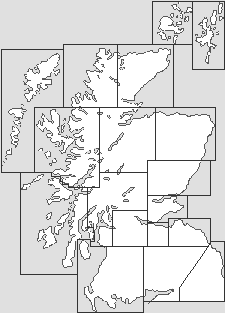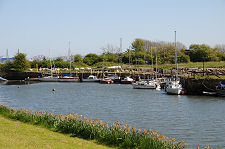 Granary and Stables |
Charlestown was a planned village created by Charles Bruce, the 5th Earl of Elgin in the 1750s. Not only did he give it his name, he also gave it his initials. The original layout of the village, still visible, is in the form of the letters "CE", from his formal title of Charles Elgin.
This was all part of Charles' grand design to make most effective use of his estate's main assets: the coal and the limestone that lay under it. Lime had been processed at neighbouring Limekilns for centuries, but what Charles Elgin built at Charlestown was on a truly industrial scale.
The village was located on higher ground a little to the north of the coast. The 30ft cliffs overlooking the sea had limekilns quarried into them: six initially, the number eventually growing to 14. These remain today, besides what is now the approach road to a new housing estate. Opposite the foot of the kilns is the harbour created to carry the quicklime and the coal to the rest of Scotland and beyond.
It is difficult to imagine today, but Charlestown was once one of the biggest and most important industrial centres in Scotland. By 1774 the limekilns and harbour were served by the Elgin Railway, which also provided a link to Dunfermline. This originally had wooden rails and the wagons were hauled by horses, for whom stables and a granary were built.
And if coal extraction and lime conversion were not enough, Charlestown already had an established iron industry using locally quarried ironstone. There had been an iron mill on the coast to the west of the site of the village from about 1630, making the metal pans in which sea water was evaporated to produce salt all along the River Forth. The bay here is still called Ironmill Bay. Later the iron ore and coal from Fife was shipped across the Forth to feed the massive Carron iron works.
In the mid 1800s the harbour at Charlestown was extended and the Elgin Railway was converted to steam. Ships were built here for a time, but a more enduring industry was ship-breaking. Some of the German Imperial Fleet refloated in Scapa Flow after the First World War were towed here to be broken up. The naval theme continues a little to the west, where the piers of the Royal Navy's armaments depot at Crombie project into the River Forth.
Lime production diminished from the 1930s and the limekilns at Charlestown finally closed in 1956. Work on their restoration began in about 1990 and today it is still possible to get a feel for the scale of what was once done here: though not the associated noise, heat and the smell.
The village itself retains much of its original plan. The Elgin Hotel was added in 1911, and a little to the north the granary and stables still stand, with the granary now converted into the village shop. Close by, in the Charlestown Workshops, is the Scottish Lime Centre, which celebrates the heritage of the industry around which Charlestown was created.
 Cottages in North Row |

|
|
|
Visitor InformationView Location on MapWhat3Words Location: ///plotter.rope.respected |
 ...and Limekilns |
 Another View of the Limekilns |
 Kilns in Closeup |




